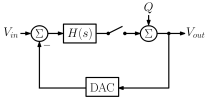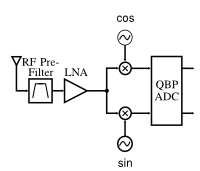
|
Continuous-time sigma delta modulation
Sigma-delta modulation is a popular scheme for realizing high accuracy A/D-convertors. Up till now, these convertors were mainly implemented in discrete-time by using switched capacitor (SC) techniques. Recently, continuous-time sigma-delta modulation has gained popularity because of its ability to work with lower supply voltage and at higher clock frequencies.
|
|
Bandpass sigma delta modulation
In many modern electronic systems, analog-to-digital (A/D) converters are essential building blocks. Especially for wireless applications, the overall performance is often determined by the embedded A/D-converter.
Furthermore, there is an evolution towards software radio. To make this possible, an A/D converter has to be placed as close as possible to the antenna. Therefore, a bandpass sigma delta modulator is interesting.
|

|
|

|
Digitaal-to-analog converters
Digital-to-analog converters are extremely important in communication systems, such as mobile phones, ADSL, ... Because the digital world shows a tendency to evolve to both higher speeds and higher precision, this research domain focuses on how performance of used architectures can be increased.
In our research group, the focus lies specifically on current-steering binary weighted DAC's that are designed so that different error causes can be compensated through calibration or mismatch shaping techniques.
|
|
Switched capacitor circuits
Circuits based on switched capacitor techniques allow to realize a wide variety of interesting systems. A great deal of the chips that have been designed in the CAS-group, is also based on switched-capacitor techniques. A typical example of this is the extended counting AD-convertor, which is particularly well suited for sensor-applications. Other examplse are the double-sampling sigma delta modulators and pipelined AD converters.
|

|
|

|
Class-D amplifiers
A "class D"-amplifier is a power amplifier where the power transistors in the
output stage are used as switches. Due to this there is no voltage across them
while they are conduciting. As a consequence of this, there are no losses in
such an amplifier, which can have a very high efficiency (in practice up to
more than 95 %).
|
|